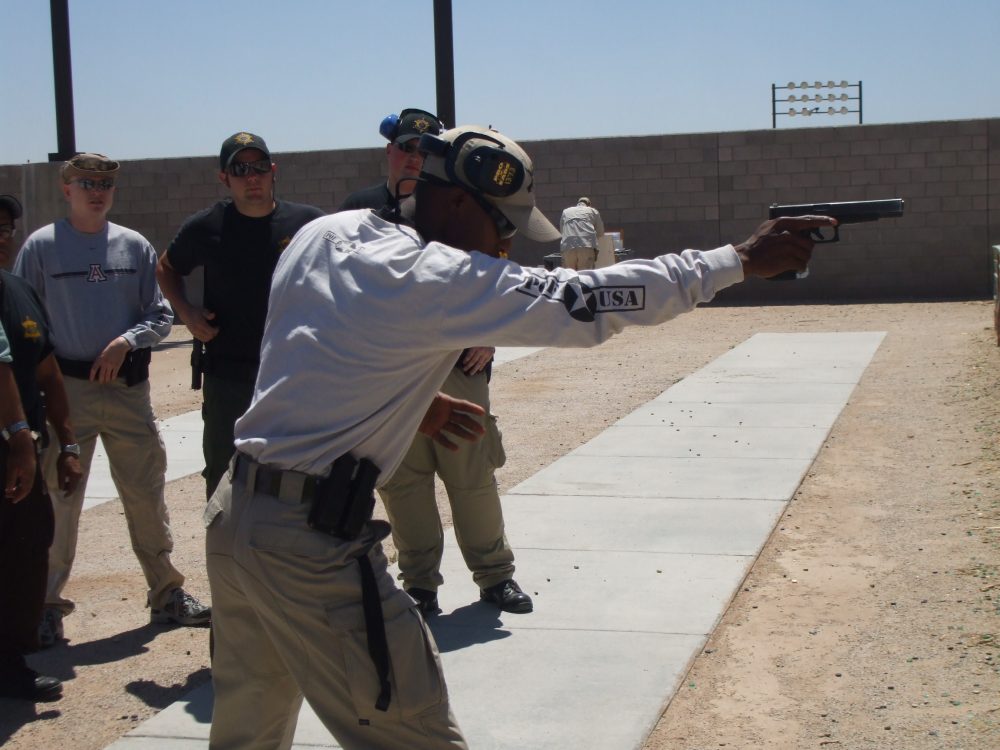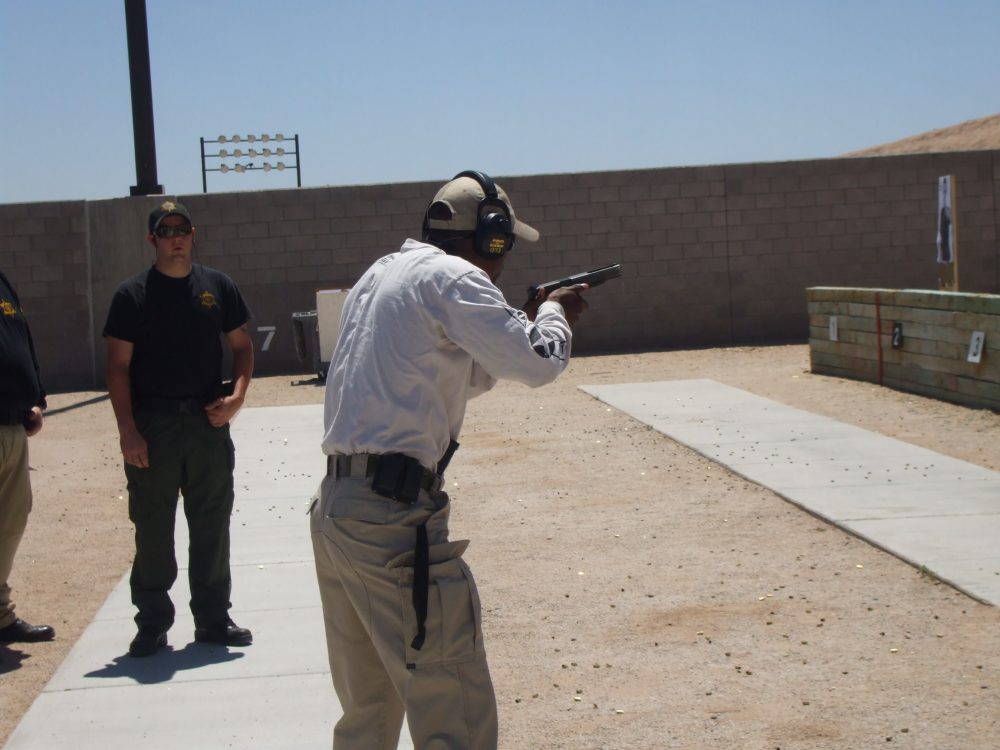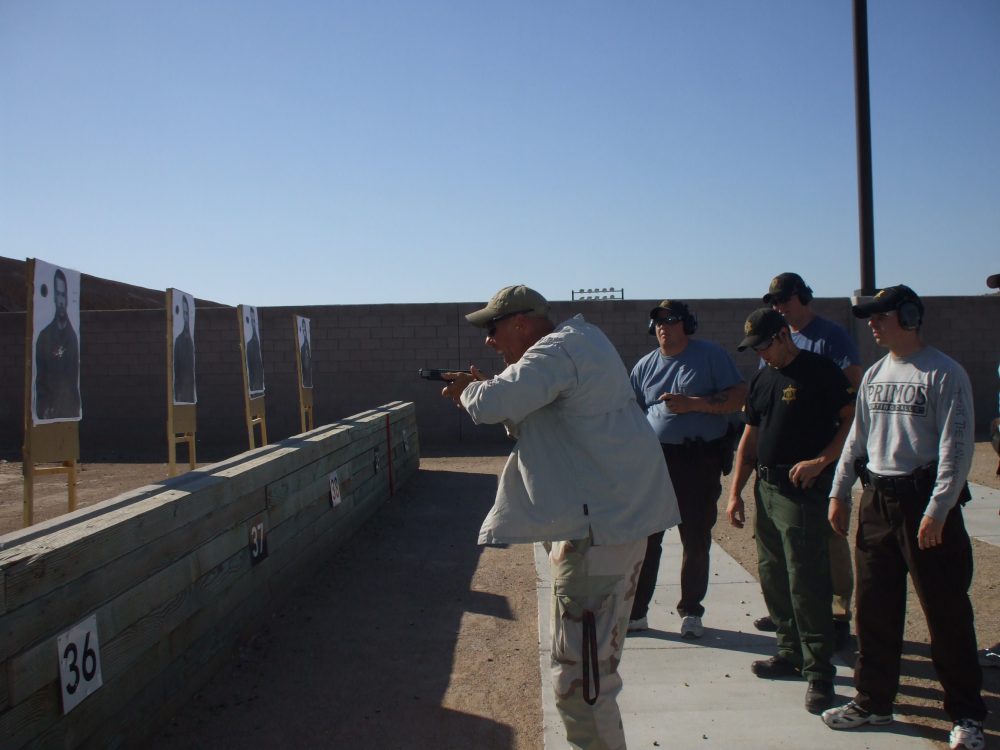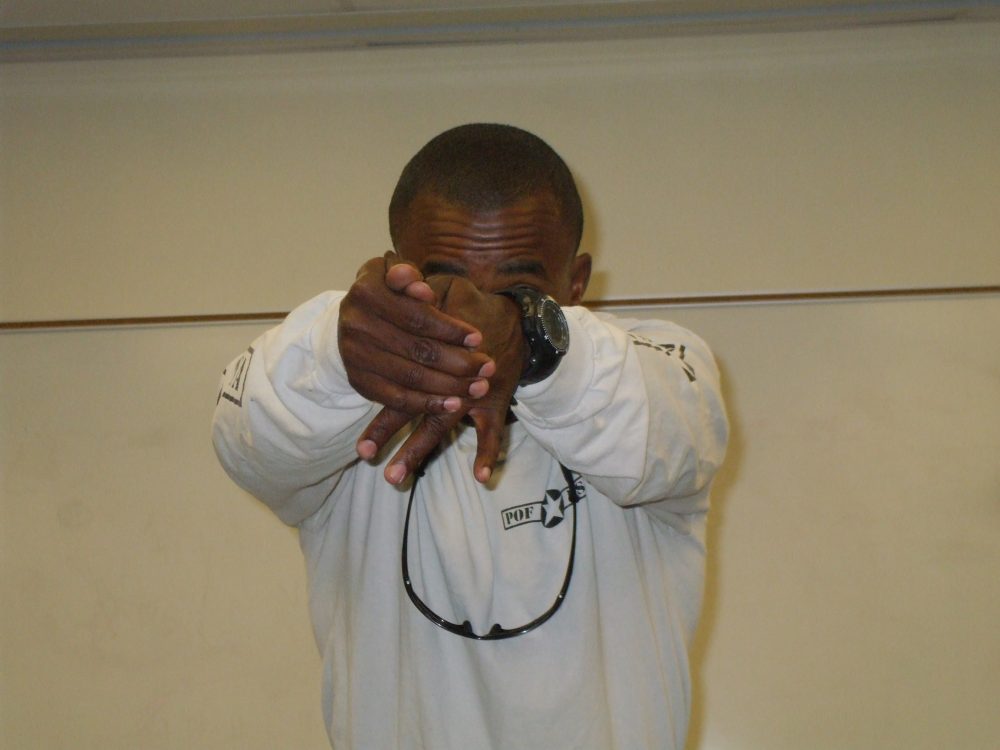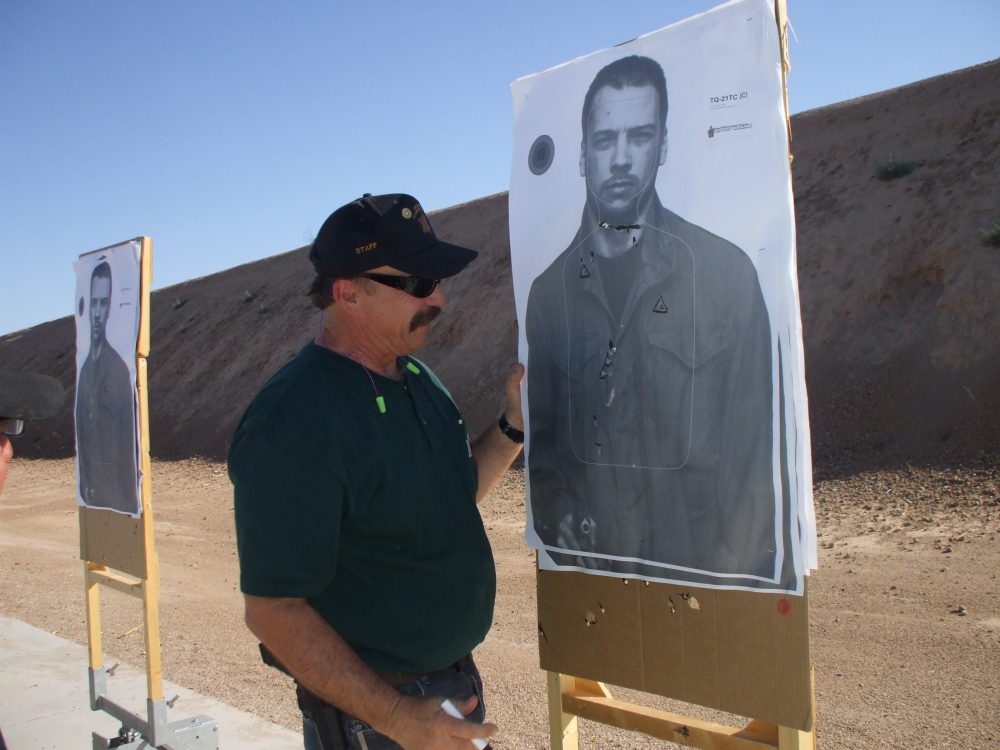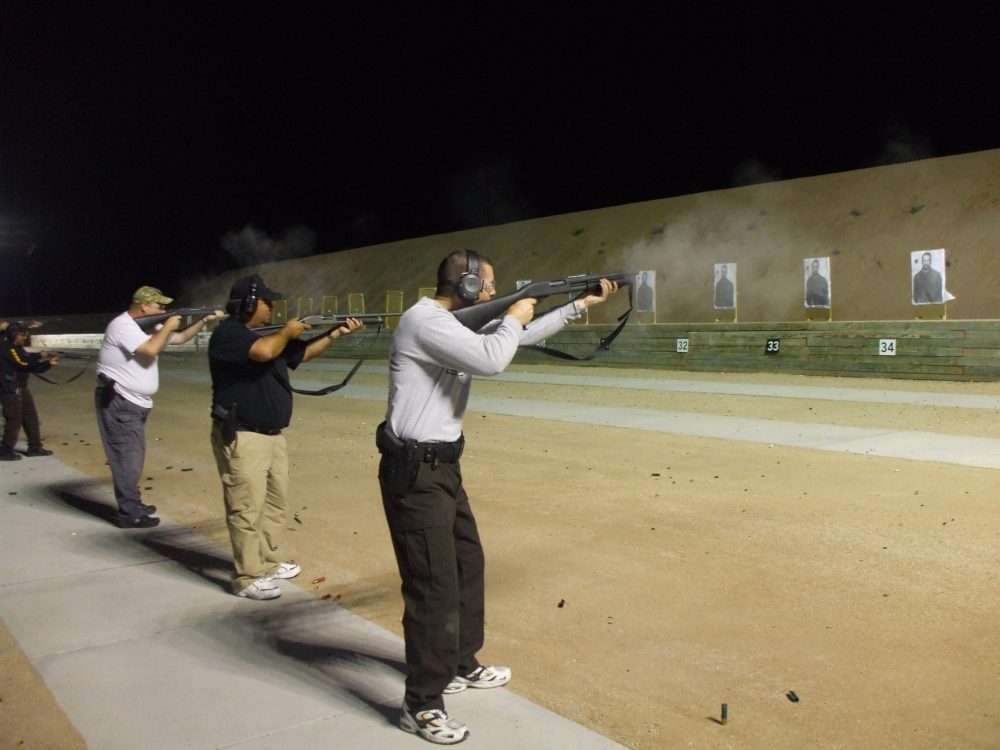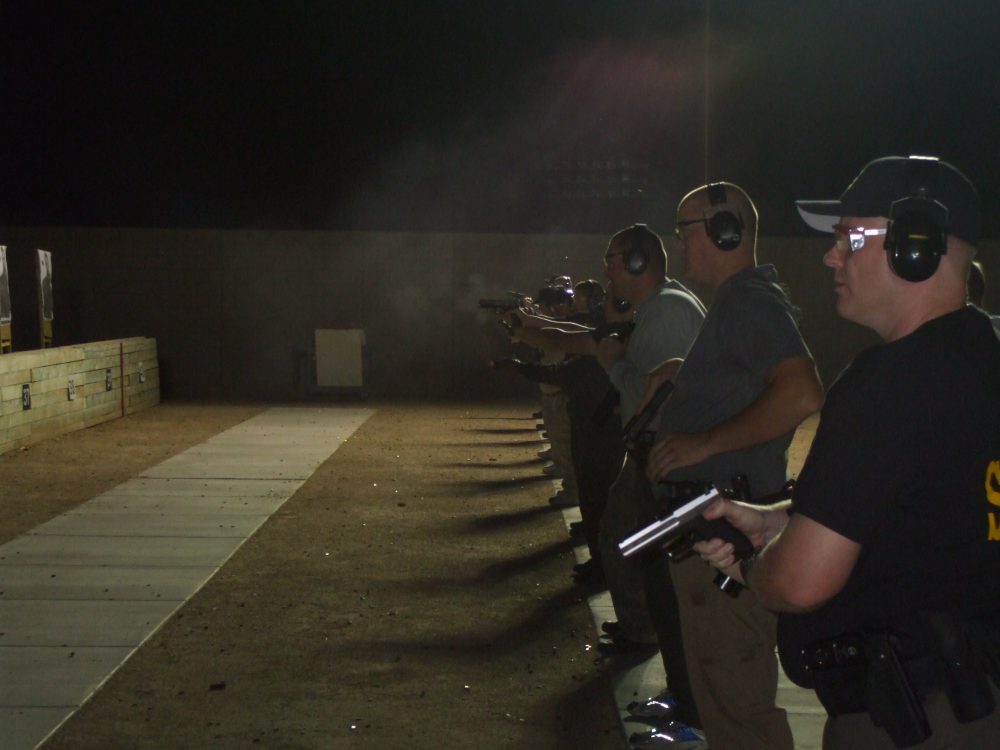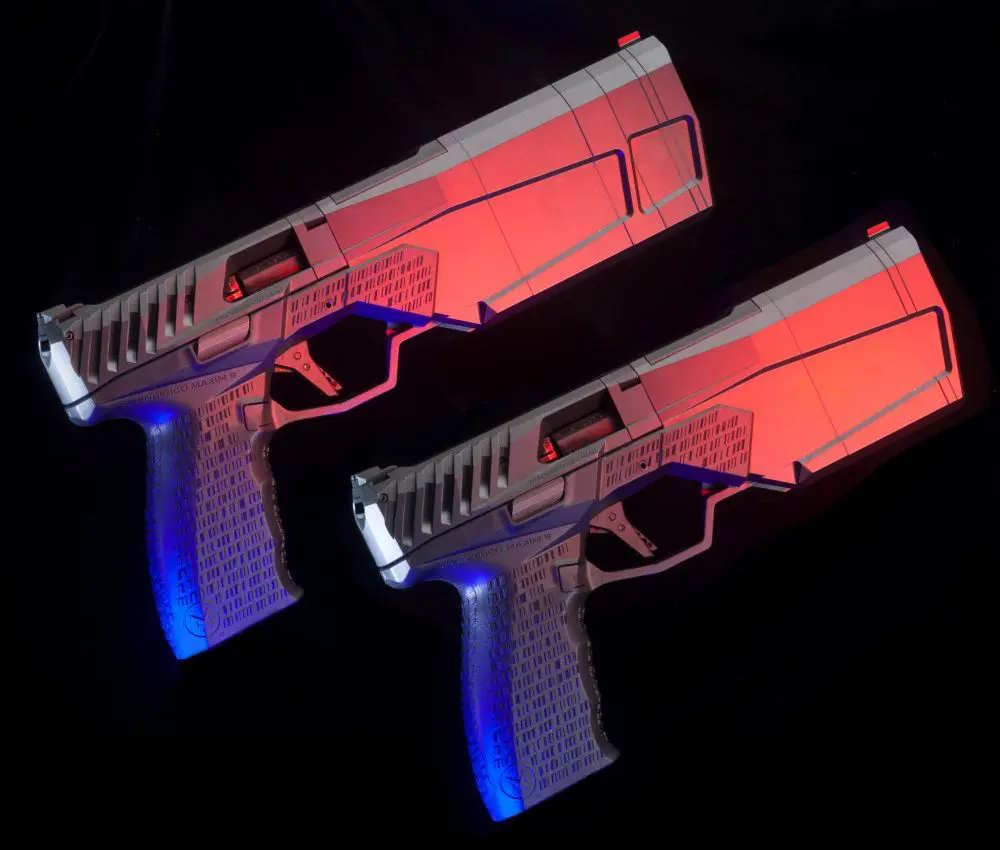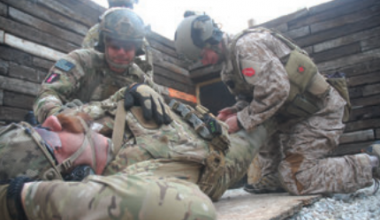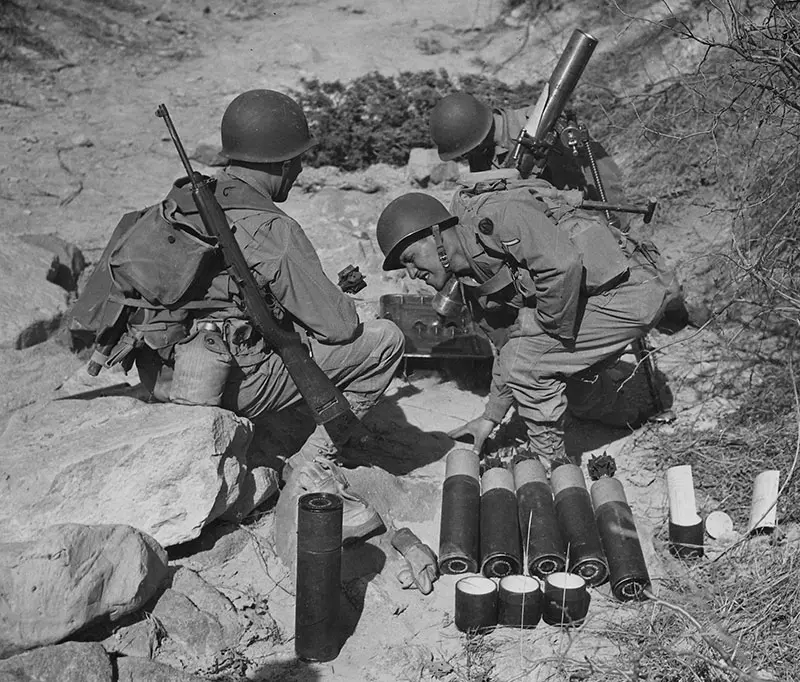Deputy Jackson demos importance of operating a weapon one-handed.
The more intensive a weapons qualification course is for officers, the better it is for everyone, from the officers themselves to the citizens they protect.
This past summer I participated in a Law Enforcement Officer (LEO) firearms qualification class through Glendale Community College outside of Phoenix, Arizona. The course was open to Maricopa County Sheriff’s Office (MCSO) detention officers, posse and reserve deputies, and deputy constables.
The class I attended consisted of 12 detention officers from different MCSO jail facilities and one deputy constable. The class took two days a week for three consecutive weeks.
Though sponsored by the college, all instruction took place at the MCSO range. This state-of-the-art facility is solar powered and one of the best ranges I have trained at.
Instructor Jackson demonstrates drill.
For the class I mainly used a Springfield chambered in .45 ACP with a SureFire X300 light on the rail (supplemented by a SureFire LX2 Lumamax on my belt) and equipped with LaserLyte’s RL-XD rear sight Laser. Holster was Blade-Tech’s Tactical Modular Mounting System worn on a Blackhawk belt with Safariland magazine and cuff pouches. I used Black Hills .45 ACP 230-gr. FMJ ammo for the pistol and Remington buckshot and slugs for the shotgun qualification.
Day One started in the classroom with an introduction of the four main instructors and an overview of the class. On the first day of each week, we would have two of the instructors, and on the second day the other two. The same four instructors would stay with us throughout the class. This proved a nice mix of the way different instructors did things and gave us a chance to draw from their varied experiences.
Later that morning, we covered law and legal and touched on mental conditioning, as well as types of gear. We discussed flashlights and spare magazines because the instructors thought these two pieces of gear are often overlooked. We inspected our weapons and field stripped them to ensure everyone knew how to clean their individual weapons and understood how they work.
After lunch we met on the range.
A safety briefing was given and everyone was instructed what to do in the event of an accident. Firearms were unloaded and checked by the instructors. This would be common throughout the course. Students were instructed to lock their slides to the rear, look in the chamber and then feel the chamber with a finger to verify the weapon was empty.
Instructor Hayes shows class that good hits can be achieved quickly up close by applying “hammer.”
We proceeded to learn a five-step drawstroke to present the weapon from the holster. Instructors emphasized that the perfect shot begins in the holster, and there can never be too much time spent on the fundamentals of shooting.
Some students had many years of training and a fairly high skill level, while others had neither. Because a class can only move as fast as the slowest student, everyone started at the same level.
After the class had practiced the five-step drawstroke slowly, we started moving while instructors called out the numbers 1, 2, 3, 4, 5. As the commands were called, students performed the motion for each number. The drill started out very slowly and then gained speed, which pushed some of the students to keep up, while others had completed the drawstroke.
With the guns still unloaded, students were paired up. One student would draw his weapon and, when on target, he would slowly press his trigger and hold it to the back while his partner would work the slide to practice trigger reset and press the trigger again and repeat. This was worked on for some time, switching between students to allow them to feel the trigger reset without recoil.
After teaching the drawstroke and trigger reset, the remainder of the day was spent on malfunction drills, teaching Type 1, 2 and 3 malfunctions and how to clear them, and what a shooter can do if they are causing the malfunction by limp-wristing or impeding the slide.
Not a single round was fired the first day. The day ended with a question and answer session.
Day Two began with two new instructors and an overview of what was to come. Each instructor talked about his training and qualifications, and then asked students for their background and what we expected from the class. Late morning found us on the range ready to shoot.
We started up close firing singles very slowly, still drawing by the five count, but now shooting live ammo.
As expected, most of the students who had little or no shooting experience struggled. The instructors worked with them individually and brought them up to speed quickly. Before lunch we started firing controlled pairs and even a few hammers. The difference showed, and the instructors talked about why hammers up close may work better than controlled pairs.
Jackson shows students in the classroom to bring the weapon up to your sight. Do not lower your head to the gun.
In the afternoon the class worked on distance shooting as far back as 25 yards, the farthest distance the Arizona Peace Officer Standards and Training Board requires shooting a pistol.
The remainder of the afternoon was spent reviewing everything we’d done. We worked on weapon clearing with dummy rounds and having our partner set up a malfunction so we couldn’t predict when or what type of failure we’d have.
Day Three started with the same two instructors we’d had on Day One. We began working under time limits so the instructors could evaluate how the students did under time and if they could move along.
Over half of the students were not getting hits and many were not getting their rounds off in time. Since we could only go as fast as the slowest student, nothing new was covered, and we spent a lot of time on single rounds and trigger reset.
One student’s gun was so bad the instructors took it and traded it in to the armory for a more user-friendly gun, which the student stayed with for the rest of the course.
A mock certification course was shot so everyone could see where they were at. Only four of us passed, some were a few points from passing, and many were off by a lot.
On Day Four, the instructors from Day Two were back and surprised to hear we’d shot a qualifying course—even a mock one—because so many students were not ready. Still, we needed to pick up the pace because there was much more we needed to cover.
We started shooting full strings of fire and working with turning targets under time, reviewing everything learned up to that point.
The instructors passed out Remington 870 shotguns and we spent the afternoon learning about them. After some classroom study, we moved to the range but stayed under the shed (temperatures were already over the century mark by noon) and worked on manipulation of the gun with dummy rounds. There was a lot of practice on loading and unloading the gun and working on select slug drills.
Instructor grades target and diagnoses some of shooter’s bad habits.
At the end of the day, we gathered back in the classroom for an overview of what we’d covered that day, and a review of the upcoming written test. The class was advised that since Arizona requires a night shoot, the last week of the school would start late and finish as late as 2300.
Day Five started late, in the heat of the day, and a quick briefing was done. The class worked on some flashlight techniques dry fire, with and without the weapon in hand.
After shooting about 100 rounds, we worked on shooting from 15 and 25 yards. The instructors advised that the 15-yard line was the “money line,” because that’s where so many rounds had to make the score. If you messed up at the 25—and just a few rounds at any other distance—it would put you out of the running.
The class then shot for score, with roughly half passing and the other half told they could retry on the last day We fired the shotgun qualification course, with all but one person passing.
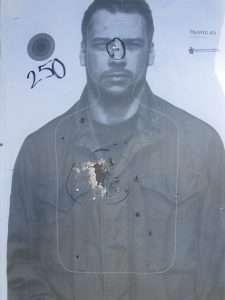
In the evening we shot both the shotgun course in low light and the low light/no light pistol qualification course. For many of the students, this was their first time shooting at night, and for almost all of the students, shooting with a flashlight was totally new.
We returned to the classroom and voted to take the written exam that night. Everyone passed the written test and we were told to arrive early the next day, because of the amount of material still left to cover.
GRADUATION DAY
Day Six started with the students’ scores posted to see where everyone placed. I had qualified “expert” the day before with my Springfield XD. Since I’d had some work done on my Kimber TLE/RL, I asked an instructor if I could qualify with it as well, and he gave his approval. (I qualified expert with the Kimber.)
We waited for the one individual (a deputy constable) who had not passed the shotgun portion of the course, but he never called or showed up. His scores were so low that it would have taken a lot to bring him up to where he would pass, and he may have felt he was holding the class back too much. But I wish he had come back, as the instructors may have been able to work with him and bring him up to a qualifying level.
So eventually we got started, first with some simple warm-up drills, pausing only long enough for one of the instructors to fine tune a couple of shooter’s sights.
At this point, most students had passed the shotgun qualification course. This was a chance for those having trouble to hone a few skills and practice fundamentals.
The students who did not initially pass the pistol qualification course were asked where they had the most trouble. Answers ranged from distance to time restrictions to general shooting discipline. The class worked through the afternoon, making sure everyone could qualify on the range part of the class. A couple more qualifying day shoots were given, with everyone passing.
After dark, a few more night qualification runs were performed, and again everyone passed at least one of them.
Finally, the students assembled in the classroom to finish some administrative paperwork. Certificates of completion were passed out and duty ammo was issued.
With the class spread out over three weeks, it gave students a chance to reflect on their individual performance and, for those who wanted to, practice what they had learned on their own time. Both the instructor cadre and the facilities were top-notch. I enjoyed this class very much and, like all courses I have ever attended, learned something new.
Night qualification shoot.
SOURCES:
Glendale Community College
Dept. S.W.A.T.
6000 West Olive Ave.
Glendale, AZ 85302
(623) 845-3000
www.gotogcc.com
Blackhawk
Dept. S.W.A.T.
6160 Commander Parkway
Norfolk, VA 23502
(800) 694-5263
www.blackhawk.com
Blade-Tech Industries
Dept. S.W.A.T.
5530 184th St. E, Ste. A
Puyallup, WA 98375
(253) 655-8059
(877) 331-5793
www.blade-tech.com
Black Hills Ammunition
Dept. S.W.A.T.
P.O. Box 3090
Rapid City, SD 57709-3090
(605) 348-5150
www.black-hills.com
LaserLyte
Dept. S.W.A.T.
101 Airpark Rd.
Cottonwood, AZ 86326
(928) 649-3201
www.laserlyte.com
Remington Arms Company, Inc.
Dept. S.W.A.T.
870 Remington Drive
P.O. Box 700
Madison, NC 27025-0700
(800) 243-9700
www.remington.com
Safariland
Dept. S.W.A.T.
3120 E. Mission Blvd.
Ontario, CA 91761
(800) 347-1200
www.safariland.com
Springfield Armory
Dept. S.W.A.T.
420 West Main St.
Geneseo, IL 61254
(800) 680-6866
www.springfield-armory.com
SureFire, LLC
Dept. S.W.A.T.
18300 Mount Baldy Circle
Fountain Valley, CA 92708
(800) 828-8809
www.surefire.com
